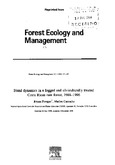| dc.contributor.author | Finegan, Bryan | |
| dc.contributor.author | Camacho, Manuel | |
| dc.date.accessioned | 2014-10-18T03:27:41Z | |
| dc.date.available | 2014-10-18T03:27:41Z | |
| dc.date.issued | 1999 | es_ES |
| dc.identifier | 358695 | es_ES |
| dc.identifier.issn | 0378-1127 | es_ES |
| dc.identifier.uri | https://repositorio.catie.ac.cr/handle/11554/4101 | |
| dc.description | 5 fig. 3 tab. 37 ref. Sum. (En) | es_ES |
| dc.description.abstract | The lowland rain forests of Central America are poorly known from the standpoint of management for timber production. We studied the stand dynamics of a logged Costa Rican rain forest under three different regimes of post-logging silvicultural treatment. The site was located on low hills with Ultisols in Holdridge's Tropical Wet Forest life zone. The Pentaclethra macroloba-dominated forest had been high graded before planned management began. Management of the 540 x 540 m (29.2 ha) experimental area began with a timber harvest in the whole area during 1989-1990, 4 trees ha-1 being cut overall for 10.1 m3ha-1. The experimental plots were 180 x 180 m (3.24 ha), comprising a 100 x 100 m (1.0 ha) central permanent sample plot (PSP) with a 40-m wide buffer strip. Two types of post-harvest silvicultural treatment: liberation/refinement (in 1991) and shelterwood (in 1992) were applied under a complete randomized block design with three replicates, using logged but untreated plots as controls. PSP data reported are for the 1988-1996 period for individuals with ó 10 cm DBH. The most marked changes in forest structure were caused by silvicultural treasment, basal area under the liberation/refinement treatment being reduced to ca. 65 per cent of its probable mature forest value. Recruitment exceeded mortality in the years following intervention under all three treatments, but forest structural recovery was slowest under the liberation/refinement treatment. Post-intervention mortality rates under appeared higher under the liberation/refinement treatment than under the control or shelterwood treatments, though differences were not statistically significant. In relation to tree attributes, mortality rates increased with decreasing DBH increment, crown illumination and quality of crown form. Commercial DBH increments were higher under the liberation/refinement treatment than in control plots during the 1993-1996 period. On the basis of its response to intervention during the first seven years of management, the forest appears resilient and productive trends over time in mortality rates under the most intense silvicultural regime require close attention however. Pentaclethra-dominated forests are important components of the productive forest resources of Costa Rica and Nicaragua and, given current deforestation rates in areas such as Southern Nicaragua, it is now urgent that the existing biophysical knowledge of these forest be applied to forest conservation and management | es_ES |
| dc.language.iso | en | es_ES |
| dc.publisher | ELSEVIER, Ámsterdam (Países Bajos) | es_ES |
| dc.relation.ispartof | Forest Ecology and Management (Países Bajos) Volumen 121, páginas 177-189 | es_ES |
| dc.rights | info:eu-repo/semantics/openAccess | es_ES |
| dc.subject | ARBOLES FORESTALES | es_ES |
| dc.subject | ORDENACIÓN FORESTAL | |
| dc.subject | BOSQUE HÚMEDO | |
| dc.subject | PARCELAS | |
| dc.subject | INCREMENTO DE DIAMETRO | |
| dc.subject | CRECIMIENTO | |
| dc.subject | COSTA RICA | |
| dc.title | Stand dynamics in a logged and silviculturally treated Costa Rican rain forest, 1988-1996 | es_ES |
| dc.type | Artículo | es_ES |


